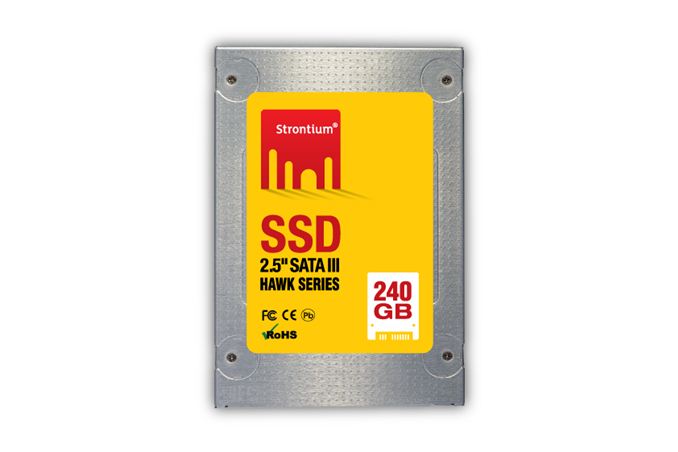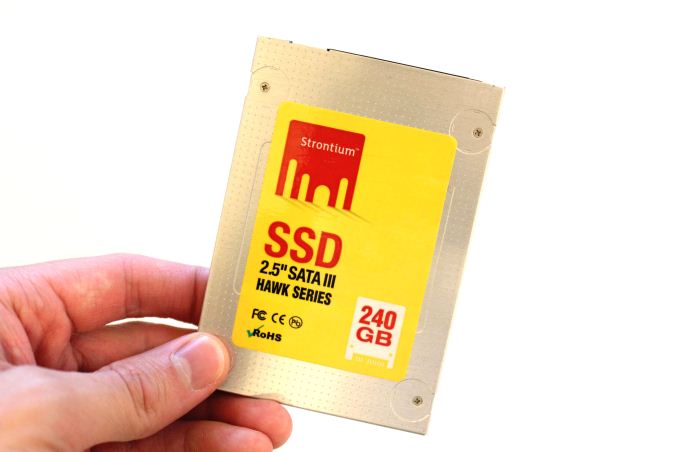Strontium Hawk (240GB) Review
by Kristian Vättö on June 25, 2013 8:00 AM EST
Strontium is probably a new acquaintance for many of our readers, but their story may be familiar. Founded in 2002 in Singapore, Strontium is one of the many memory manufacturers who have turned to SSDs to expand their product portfolio and increase revenues. Dozens of companies that have done the same: OCZ, Kingston, Mushkin, Crucial/Micron, ADATA, and Corsair to name a few. It's logical because the same companies that manufacture DRAM often make NAND too, so the contacts and channels are already in place. When you add the fact that all the controller/firmware technology can be licensed from SandForce (or Marvell if you're willing to invest in firmware), you don't actually need much in-house engineering to build an SSD.
What makes Strontium special is the fact that they actually buy the whole SSD from a third party and simply rebrand it. In case of the Hawk, Strontium sources the SSD from Toshiba, although they've at least had SK Hynix as their supplier as well in the past. Now, this isn't anything unheard of; readers who have followed the SSD scene for longer may remember Kingston's SSDNow M series SSDs, which was a rebranded Intel X25-M G2. However, to date I've not come by a company whose business model relies completely on rebranding SSDs. Strontium told me that after long-term evaluation they decided to go with a proven, high-quality product and focus their resources on other aspects such as validation and marketing. Strontium didn't go into detail about their validation methods but they told me that they verify that the products they ship perform to the spec provided by the actual manufacturer (including reliability tests).
There's even the original Toshiba sticker on the back of the drive
Due to Strontium's headquarters location, their main market is still in Asia. Strontium does have an office in the US but unfortunately none of the bigger retailers stock their SSDs currently. They do have their own online store that ships to US, though.
| Strontium Hawk Specifications | |
| Capacities | 120GB & 240GB |
| Controller | Toshiba TC58NC5HA9GST |
| NAND | Toshiba 19nm Toggle-Mode 2.0 MLC |
| Sequential Read | Up to 534MB/s |
| Sequential Write | Up to 482MB/s |
| 4KB Random Read | Up to 90K IOPS |
| 4KB Random Write | Up to 35K IOPS |
| Warranty | Three years |
The Hawk is available in capacities of 120GB and 240GB but as you can see in the Toshiba sticker above, the drive is actually 256GB. What's weird is that the drive also shows up as a 256GB drive (or 238.5GiB as it's displayed in Windows). At first I thought there was a problem with my sample as Strontium had switched suppliers (I'll get to this soon), but Strontium told me that they advertise the drive based on the capacity available to the end-user. In other words, Strontium markets it as 240GB because it shows up as a 238.5GiB drive in Windows due to the difference between Giga and Gibibyte. I wouldn't have a problem if it was Intel or some other major SSD OEM doing this as they could change the way GB is defined in the storage industry, but I don't see the point for a small-ish company like Strontium to do that. The only thing they will do is confuse buyers because everyone else is defining GB as 1000^3 bytes.
The other thing I'm not happy about is that Strontium changed the supplier earlier this year but kept the product name the same. It's normal for SSD OEMs to use multiple NAND suppliers and that's fine, but Strontium changed the whole SSD including the controller. The original Hawk was manufactured by SK Hynix and it was based on SandForce's SF-2281 controller and 26nm Hynix NAND (see e.g. Strontium's PR and Legit Reviews' review). My sample, on the other hand, is made by Toshiba and it has a Toshiba-Marvell controller coupled with 19nm Toshiba NAND.
Such a radical change should definitely require a change in the series name too since we are dealing with two very different SSDs. Strontium even has another SSD series called Python that uses an SF-2281 controller, so I fail to see why Strontium didn't for example name the Toshiba drive as Python and keep Hawk for the SF-2281 based drive. As far as I know, we are the first site to review the new version of the Hawk, meaning that potential buyers have had no idea that their drive might not be SF-2281 based like all the reviews are claiming. But let's see how the numbers line up first.












26 Comments
View All Comments
karasaj - Tuesday, June 25, 2013 - link
Every time I kept reading that, I kept thinking about how no name suppliers would be bad... hard to remember it's from Toshiba, haha. Good luck to them. Nice review :) Power consumption seems obnoxiously low at load.mcveigh - Tuesday, June 25, 2013 - link
Strontium Hawk is the name of my spirit animal!jmke - Tuesday, June 25, 2013 - link
not the best product name I must admit... might not do well in Benelux ;)http://translate.google.com/?hl=en#nl/en/stront
Pessimism - Tuesday, June 25, 2013 - link
Why poo-poo the manufacturer for taking a stand to end the 1000^3 garbage? Everyone should follow suit and label with formatted capacity.hedleyroos - Tuesday, June 25, 2013 - link
Your use of the word "poo-poo" is ironically funny to people who speak Afrikaans (and probably Dutch and Flemish) since "stront" means "poo". They have zero chance of succeeding in those markets.Kristian Vättö - Tuesday, June 25, 2013 - link
Like I said, it's pretty much useless for a small OEM like Strontium to try and change the industry.piroroadkill - Tuesday, June 25, 2013 - link
It should then say 240GiB...dealcorn - Tuesday, June 25, 2013 - link
OK. Laptops outsell desktops and you were unable to test with HIPM and DIPM enabled and no mention was made of DEVSLP support which is a big deal for any Haswell mobile device. By impairing the relevance of the review to typical use cases, someone properly earns a demerit.You need a Haswell mobile device to test with if you want to maintain relevance to the mainstream market. I would complain to my bosses that you need better hardware support to perform at the level they and readers expect of you.
Kristian Vättö - Tuesday, June 25, 2013 - link
I'll be brutally honest here. Just because we are AnandTech doesn't mean that we have piles of laptops laying around, especially ones that are based on a chip that was released less than a month ago. All reviewers want Haswell-based devices at the moment, the supply is extremely tight. Usually laptops only have a review time of two weeks or so because the same system may be sent to others once it's been returned. Obviously reviewers who are actually going to review the system are the first priority, so it'd be really hard for me to get one because 1) I would only be using it for one test 2) I couldn't send it back anytime soon. In other words, the manufacturer wouldn't get much bang for their marketing $ because they wouldn't get much visibility, which is the reason review samples exist in the first place.I know there's the option of buying one but again, I'll be honest here: It would be around $1000 for just one test. I would definitely take one if Anand paid for it but as far as I've understood, Anand isn't into spending thousands on test equipment (keep in mind that the financial situation isn't all that good for us since it's usually the marketing budgets that get cut when bad times hit, so it's harder for us to get advertisers). There's a ton of stuff I'd love to have as they would really take our SSD tests (especially power related) to a next level but I'm not the one making decisions.
We have talked with Intel and ASUS and asked if there's anyway HIPM/DIPM could be enabled on a desktop system (even via custom firmware) but as far as I know, they are not up for that.
Trust me, I would take a Haswell laptop on a heartbeat if someone gave me one, but I hope you also understand that we don't get whatever we want from manufacturers.
dealcorn - Tuesday, June 25, 2013 - link
Well handled and responsive to my concern. So, BK is telling his team we have a winning hand but we need to release products faster. Anandtech is arguably the premier web site consumers turn to for help understanding how new technology benefits them. Intel, however, makes no effort to ensure you have access to the hardware necessary to explain why consumers should value the new stuff. If Intel is trying to increase the cadence, they should step up their game. If Intel does not understand that, it lessens BK's credibility.